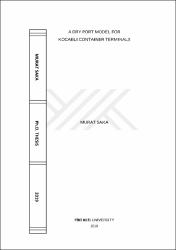A dry port model for Kocaeli container terminals
Künye
Saka, Murat. (2020). A dry port model for Kocaeli container terminals. (Yayınlanmamış Doktora Tezi). Piri Reis Üniversitesi, Fen Bilimleri Enstitüsü, Deniz Ulaştırma İşletme Mühendisliği Ana Bilim DalıÖzet
Deniz yolu taşımacılığındaki artış, küresel ticaretteki artışa bağlı olarak devam etmektedir. Deniz yolu taşımacılığı türleri arasında son yıllarda en hızlı artış gösteren taşıma türü ise konteyner taşımacılığı olmuştur. Deniz aşamasından sonra iç taşımada da büyük kolaylık sağlayan konteyner, intermodal taşımacılığın da gelişmesini tetiklemiştir. Artan dış ticaret hacmi, limanlar üzerindeki yükü de artırmaktadır. Türkiye'nin dış ticareti açısından önemli bir kapısı durumunda olan, ancak kentsel alanlar ile çevrelenmiş olmaları nedeniyle genişleme imkânları son derece kısıtlı olan Kocaeli limanları, bu yükü oldukça ciddi boyutta hissetmektedirler. Konteyner trafiğindeki artış dikkate alındığında, Kocaeli konteyner terminallerinin toplam mevcut kapasitesinin, 2035 yılında oluşması beklenen talebi karşılamada yetersiz kalacağı hesaplanmıştır. Kuru liman uygulamasının, ihtiyaç duyulacak ilave kapasitenin yaratılması, ayrıca limanlarda ve liman şehirlerinde oluşacak tıkanıklığı belli bir oranda rahatlatabilmek için uygun bir çözüm yöntemi olacağı düşünülmektedir. Bu şekilde, kapasite sorunu nedeniyle sorun yaşamak üzere olan bir limanın işlem hacmini ve gelirini artırabileceği öngörülmektedir. Bu tez çalışması, Kocaeli konteyner terminallerinin gelecekte yaşayabileceği bu tür problemlere bir çözüm üretmeyi hedeflemektedir. Tezde sayısal yöntem kullanılmıştır. Öncelikle, 2035 yılında gerçekleşmesi muhtemel konteyner trafiği dikkate alınarak, Kocaeli limanlarını bu açıdan destekleyecek bir kuru limanın sahip olması gereken yetenekler ortaya konmuştur. Müteakip aşamada ise bu yeteneklere sahip olacak kuru liman için en uygun lokasyon bir AHP modeli ile belirlenmiştir. AHP modelinde kullanılan kriterlerin ağırlıkları, konu ile ilgili 11 sektörden toplam 94 uzmanın katıldığı bir anket ile belirlenmiştir. Son aşamada ise bir kuru liman ile koordineli çalışacak olan deniz limanı otoritesinin, beklenen yük durumu karşısında işlem hacmini ve gelirini azami seviyeye çıkarabilmesi maksadıyla gelen yükü ne oranda istiflemesi ve hangi oranda kuru limana göndermesi gerektiğini ortaya koyan bir optimizasyon modeli geliştirilmiştir. Bu model 2030'lu yıllara uygun bir vaka çalışması ile test edilmiştir. Modelin çalıştırılması neticesinde deniz limanı ile kuru liman arasında sağlanacak ulaştırma kapasitesinin son derece önemli bir faktör olduğu; uygulamanın, deniz limanının yanı sıra kuru liman ve demiryolu operatörü açısından da ilave faydalar sağlayacağı tespit edilmiştir. Ayrıca, yükün kamyon taşımacılığı yerine çevre dostu bir taşıma türüne transferi neticesinde, liman şehri üzerindeki zararlı gaz emisyonunun da belli bir oranda azaltılabileceği, diğer bir ifadeyle çevresel açıdan da fayda temin edilebileceği değerlendirilmektedir. The increase in maritime transport continues due to the increase in global trade. The containerized trade has recently been the fastest-growing segment among all types of maritime transport. The container, which provides great convenience through inland transport after the sea phase, has also triggered the development of intermodal transport. This situation is prominently observed in Kocaeli ports, which perform as an important gate for Turkish foreign trade. These ports almost have very limited opportunities to increase the stacking capacity by expanding their land areas, since they are surrounded by urban settlements. Considering the increase in container traffic, it was calculated that the total available capacity of Kocaeli container terminals would be insufficient to meet the expected demand in 2035. It is considered that the dry port implementation could be an appropriate method to create additional capacity that would be needed. It would also relieve congestion in ports and port cities to a certain extent. In this way, it is foreseen that a port which is about to be constrained due to the capacity problem may increase its transaction volume and revenue. This thesis aims to solve such problems that Kocaeli container terminals may face in the future. Quantitative method was applied in this thesis. First of all, taking into account the possible container traffic in 2035, the capabilities that a dry port should have to be able to support the Kocaeli ports have been examined. In the following stage, the most suitable location for the dry port that would have the required capabilities was determined by an AHP model. The weights of the AHP criteria were determined by a survey method to which 94 experts took part from 11 sectors. In the last stage, an optimization model has been developed to help the sea port authority in the decision-making process for the incoming cargo when the seaport is about to be constrained due to the lack of the space if it is collaborating with a dry port. This optimization model aims to maximize the productivity and the income of the seaport depending on the container transactions. To this end, if the amount of cargo that would arrive for the coming periods is known, the solution of the model reveals how much cargo should be stacked in the terminal and how much should be sent to the dry port. This model was tested with a case study that could be encountered in the 2030s. It is seen that the transportation capacity to be provided between sea port and dry port is an extremely important factor. Besides, it has been determined that dry port implementation will provide additional benefits for dry port and railway operator as well as sea port. On the other hand, it is considered that as a result of transferring the cargo to the railroad which is an environmentally friendly type of transport instead of truck, the traffic disturbance in the port city and the associated harmful gas emission would be reduced to a certain extent.
Bağlantı
https://tez.yok.gov.tr/UlusalTezMerkezi/TezGoster?key=4J_FzTwlrMCH4qBROpXPH569t6TZwGTVjjPhvdNKY0i6ASImw3v2YH4St0uzJrSdhttps://hdl.handle.net/20.500.12960/54
Koleksiyonlar
- Tez Koleksiyonu [34]

















